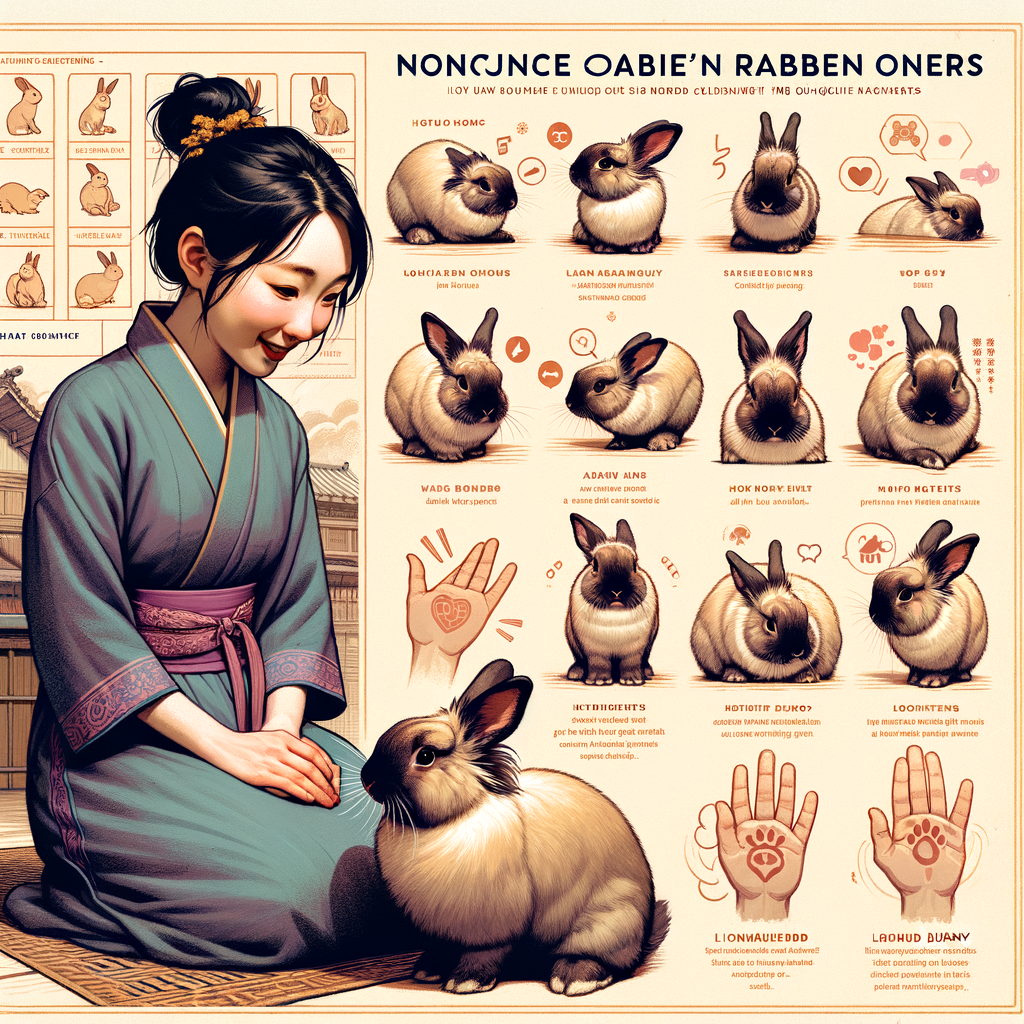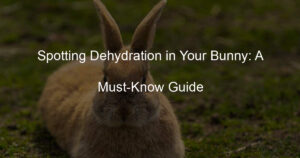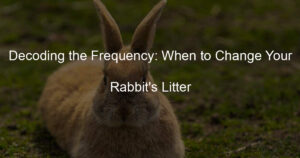
Introduction to Lionhead Rabbit Behavior
Welcome to our comprehensive guide on Lionhead rabbit behavior. If you’re a new bunny owner or considering adopting a Lionhead rabbit, understanding their behavior is key to building a strong bond with your furry friend.
- Overview of Lionhead rabbits
- Importance of understanding rabbit behavior
Lionhead rabbits are a unique breed known for their distinctive mane of fur around their heads, resembling a lion’s mane. They are small to medium-sized rabbits, typically weighing between 2.5 to 3.75 pounds. Originating from Belgium, these rabbits are now popular pets worldwide due to their friendly and playful nature.
One of the key aspects of Lionhead rabbits is their behavior. They are known to be sociable, intelligent, and active. They enjoy the company of their human companions and can be quite playful. However, like all rabbits, they also need their quiet time and can be a bit shy at first.
Understanding your Lionhead rabbit’s behavior is crucial for several reasons. Firstly, it helps you provide the right care and environment for your rabbit. For instance, if your rabbit is constantly chewing, it might be a sign that they need more hay or chew toys.
Secondly, understanding your rabbit’s behavior can help you bond with them. Rabbits communicate through a variety of behaviors, and recognizing these can help you understand their needs and feelings. For example, if your rabbit thumps its hind legs, it could be a sign that they are scared or upset.
Lastly, understanding rabbit behavior can help you spot any changes that might indicate health issues. Rabbits are good at hiding their illnesses, so changes in behavior can often be the first sign that something is wrong.
Throughout this guide, we’ll delve deeper into the fascinating world of Lionhead rabbit behavior, providing you with the knowledge you need to understand and care for your bunny. So, let’s hop right in!
Understanding Rabbit Behavior: A Guide for First-Time Bunny Owners
As a new bunny owner, understanding your rabbit’s behavior is crucial. This guide will help you understand why it’s important and clear up some common misconceptions about rabbit behavior.
- Why is understanding rabbit behavior important?
Rabbits are unique creatures with their own set of behaviors and communication methods. Understanding these behaviors can help you build a stronger bond with your bunny, ensure their wellbeing, and provide them with a comfortable and safe environment. For instance, a rabbit thumping its hind legs is a sign of fear or warning, while a bunny nuzzling its nose against you is a sign of affection.
Moreover, recognizing signs of stress or illness early can help prevent serious health problems. For example, a lack of appetite or changes in litter box habits could indicate a health issue that needs immediate attention.
- Common misconceptions about rabbit behavior
There are several misconceptions about rabbit behavior that can lead to misunderstandings and potentially harm your relationship with your bunny. Here are a few:
Myth 1: Rabbits are low-maintenance pets. In reality, rabbits require a lot of care and attention. They need daily exercise, a balanced diet, and regular vet check-ups. They also need mental stimulation, which can be provided through toys and interaction with their owners.
Myth 2: Rabbits love to be cuddled. While some rabbits may enjoy being cuddled, others may find it stressful. Rabbits are prey animals and being held can make them feel trapped. It’s important to respect your rabbit’s boundaries and learn to read their body language.
Myth 3: Rabbits are happy living in a cage all the time. Rabbits need plenty of space to hop around and explore. Keeping a rabbit confined to a cage all the time can lead to boredom, depression, and health issues such as obesity.
Understanding your rabbit’s behavior and debunking these common myths can help you provide the best care for your bunny and build a strong, loving relationship with them.
Deciphering Rabbit Lingo: A Rabbit Behavior Guide
Understanding your Lionhead bunny’s behavior is key to building a strong bond with your furry friend. Let’s delve into some common behaviors exhibited by these adorable creatures.
Common Lionhead Bunny Behaviors
Here are some behaviors you might observe in your Lionhead bunny:
- Thumping: Thumping is a common behavior in rabbits. When a bunny thumps its hind legs, it’s usually a sign of fear or warning. Your bunny might be sensing danger or feeling threatened. It’s their way of alerting others in the warren. If your bunny starts thumping, it’s a good idea to check their surroundings for anything that might be causing them distress.
- Binky: A ‘binky’ is a joyful expression in rabbits. It’s when your bunny jumps into the air, twists its body and kicks out its legs. This is a sign of pure happiness and contentment. If your bunny is doing binkies, it means they’re extremely happy and comfortable in their environment.
- Flopping: Flopping is when your bunny throws itself onto its side. This might look alarming, but it’s actually a sign of relaxation. When a bunny flops, it means they’re feeling safe and secure. It’s a sign of trust and comfort in their environment.
Understanding these behaviors can help you better cater to your bunny’s needs and ensure they’re happy and comfortable in their home. Remember, every bunny is unique and might express these behaviors differently. The key is to spend time with your bunny and learn their individual personality and behavior patterns.
Understanding Aggressive Rabbit Behaviors
While rabbits are generally known for their gentle and friendly nature, they can sometimes display aggressive behaviors. It’s essential to understand these behaviors to ensure the safety and well-being of both you and your pet rabbit. Let’s delve into some of the most common aggressive rabbit behaviors.
- Growling
- Charging
- Biting
Yes, rabbits can growl! It might come as a surprise, but a growling rabbit is usually a sign of fear or annoyance. If your bunny growls at you, it’s best to give them some space and try to figure out what might be causing their discomfort.
Charging is another aggressive behavior exhibited by rabbits. This usually happens when a rabbit feels threatened or territorial. It’s important to note that charging can sometimes lead to biting, so it’s crucial to handle this behavior with care. Try to calm your rabbit down and remove any potential threats from their environment.
Biting is a clear sign of aggression in rabbits. It often occurs when a rabbit feels cornered or scared. If your rabbit bites, it’s important not to punish them, as this can make the behavior worse. Instead, try to understand the root cause of their fear and work on eliminating it.
Remember, understanding your rabbit’s behavior is key to maintaining a healthy and happy relationship with them. If you notice any sudden changes in their behavior, it’s always a good idea to consult with a vet or a rabbit behavior expert.
Lionhead Bunny Care: Responding to Your Rabbit’s Behavior
Understanding your Lionhead bunny’s behavior is crucial to providing the best care possible. Responding appropriately to their actions can help strengthen your bond and ensure their happiness. Let’s explore how to respond to both positive and negative behaviors.
- How to respond to positive behaviors
- How to respond to negative behaviors
Positive behaviors in Lionhead bunnies include grooming, binkying (a happy jump and twist in the air), and flopping (lying down contentedly). When your bunny displays these behaviors, it’s a sign they’re happy and comfortable.
Respond to these behaviors with gentle petting and praise. You can also reward your bunny with a healthy treat, like a small piece of carrot or apple. Remember, positive reinforcement encourages the repetition of these behaviors.
Negative behaviors in Lionhead bunnies can include biting, thumping, and hiding. These behaviors can indicate fear, stress, or discomfort. It’s important to understand that your bunny isn’t ‘bad’ – they’re simply communicating their feelings to you.
When your bunny displays negative behaviors, avoid punishment. Instead, try to identify and remove the source of their stress. Provide a quiet, safe space for them to calm down. If the behavior continues, consult with a vet or a rabbit behavior expert to ensure your bunny isn’t experiencing any health issues.
In conclusion, responding appropriately to your Lionhead bunny’s behavior is key to their well-being. By understanding and reacting to their positive and negative behaviors, you can ensure your furry friend feels safe, loved, and happy in your care.
Rabbit Behavior Meanings: What Your Bunny is Trying to Tell You
Understanding your rabbit’s behavior is key to building a strong bond with your furry friend. Rabbits have their own unique ways of communicating, and it’s up to us to learn their language. In this section, we’ll explore two main areas: interpreting body language and understanding vocal cues.
- Interpreting body language
Rabbits use their bodies to express a variety of emotions and intentions. Here are a few common rabbit body language signs:
| Body Language | Meaning |
|---|---|
| Standing on hind legs | Your rabbit is curious and trying to get a better view of its surroundings. |
| Thumping hind foot | This is a warning sign that your rabbit senses danger. |
| Lying flat on the ground | Your rabbit is relaxed and comfortable. |
Remember, these are just general guidelines. Each rabbit is unique and may have its own variations of these behaviors.
- Understanding vocal cues
While rabbits are generally quiet animals, they do make some noises to communicate. Here are a few common vocal cues:
| Vocal Cue | Meaning |
|---|---|
| Purring | Your rabbit is content and happy. |
| Growling | Your rabbit may be feeling threatened or annoyed. |
| Whining | Your rabbit may be uncomfortable or in pain. |
Again, these are general guidelines. Your rabbit may have its own unique sounds.
By paying close attention to your rabbit’s body language and vocal cues, you can better understand its needs and emotions. This will help you build a stronger bond with your bunny and ensure it feels safe and loved.
New Bunny Owner Tips: Navigating Your Rabbit’s First Few Weeks
Bringing a new bunny home is an exciting time, but it can also be a little daunting. There’s so much to learn about your new furry friend and how to care for them. Here are some tips to help you navigate your rabbit’s first few weeks at home.
-
Preparing Your Home for a Rabbit
Before bringing your new bunny home, it’s important to make sure your home is rabbit-ready. Here are a few things to consider:
- Rabbit-proofing: Rabbits love to chew, so make sure all wires, cords, and potentially harmful items are out of reach.
- Space: Rabbits need plenty of space to hop around. Make sure they have a large, safe area to explore.
- Litter box: Yes, rabbits can be litter trained! Start by placing a litter box in their cage.
- Food and water: Always have fresh hay, water, and rabbit food available for your bunny.
-
Introducing Your Rabbit to Its New Home
Once your home is prepared, it’s time to introduce your rabbit to its new environment. Here are some tips:
- Slow and steady: Allow your rabbit to explore their new home at their own pace. It might take a few days for them to feel comfortable.
- Quiet time: Try to keep your home quiet and calm for the first few days. Too much noise or activity can be stressful for your bunny.
- Patience: It might take some time for your rabbit to adjust to its new home. Be patient and give them the time they need.
In conclusion, preparing your home for a rabbit and introducing your rabbit to its new home are two crucial steps to ensure a smooth transition for your new pet. Remember, patience and understanding are key during this time. Happy bunny parenting!
Lionhead Rabbit Characteristics: What Makes Them Unique
As a bunny owner, you may have noticed that your Lionhead Rabbit is quite different from other breeds. These unique rabbits have distinct physical and behavioral characteristics that set them apart. Let’s delve into what makes them so special.
- Physical characteristics
Lionhead Rabbits are known for their distinctive mane of fur around their head, which resembles a lion’s mane, hence their name. They are small to medium-sized rabbits, typically weighing between 2.5 to 3.75 pounds. Their body is compact and well-rounded, with a broad head and bold eyes that show a lively and friendly expression. The ears of a Lionhead Rabbit are shorter than those of many other rabbit breeds, standing upright and measuring between 2 to 3 inches long. Their fur is medium in length, dense, and soft to the touch.
| Physical Characteristic | Description |
|---|---|
| Size | Small to medium, 2.5 to 3.75 pounds |
| Body | Compact and well-rounded |
| Head | Broad with bold eyes |
| Ears | Short and upright, 2 to 3 inches long |
| Fur | Medium length, dense, and soft |
- Behavioral characteristics
Lionhead Rabbits are known for their friendly and sociable nature. They are intelligent and curious, often showing interest in their surroundings and their human family members. These rabbits are generally good with children and can be easily trained to use a litter box. They enjoy playtime and need mental stimulation to keep them happy and healthy. However, like all rabbits, they can be a bit shy or skittish at times, especially in new or unfamiliar environments.
It’s important to remember that every Lionhead Rabbit is unique, and their behavior can vary depending on their individual personality and experiences. As a responsible bunny owner, understanding your rabbit’s unique characteristics can help you provide the best care possible for your furry friend.
Rabbit Behavior for Beginners: Common Questions Answered
Understanding your rabbit’s behavior can sometimes be a bit of a challenge, especially for first-time bunny owners. However, with a bit of patience and observation, you can learn to decipher your rabbit’s unique language. In this section, we will answer some of the most common questions about rabbit behavior.
- Why does my rabbit thump?
- Why does my rabbit chew everything?
Rabbits thump their hind legs as a way to communicate. This behavior is often a sign of fear or warning. When a rabbit thumps, it’s usually because they’ve sensed danger and are alerting others. It’s their way of saying, “Be alert, something’s not right.” However, sometimes, rabbits may also thump when they’re annoyed or seeking attention.
Chewing is a natural behavior for rabbits. In the wild, rabbits chew on grass, plants, and bark to keep their teeth from growing too long. Domestic rabbits continue this behavior, and they may chew on furniture, wires, and other household items if they don’t have appropriate toys or materials to chew on. Providing your rabbit with plenty of safe chew toys can help redirect this behavior and protect your belongings.
Understanding these behaviors is the first step towards building a strong bond with your rabbit. Remember, every rabbit is unique and may express these behaviors differently. The key is to observe and learn from your rabbit’s behavior. With time and patience, you’ll become an expert in understanding your rabbit’s unique language.
Table: Common Rabbit Behaviors and Their Meanings
| Behavior | Meaning |
|---|---|
| Thumping | Sign of fear, warning, or annoyance |
| Chewing | Natural behavior to keep teeth from growing too long, can also be a sign of boredom or lack of appropriate chew toys |
In conclusion, understanding your rabbit’s behavior is crucial to ensure their well-being and happiness. By observing and learning from your rabbit’s behavior, you can provide them with the care and attention they need to thrive.
Conclusion: Embracing Your Lionhead Rabbit’s Unique Personality
As we conclude our journey into understanding the behavior and personality of your Lionhead rabbit, it’s important to remember that each bunny is unique. Embracing their individuality and continuing to learn about their behavior will not only make you a better bunny owner, but also strengthen the bond you share with your furry friend.
- Appreciating your rabbit’s individuality
- Continuing to learn about rabbit behavior
Just like humans, every Lionhead rabbit has its own personality. Some might be more outgoing, while others might prefer their own company. Some might love to explore, while others might be more content staying in one place. It’s essential to appreciate these differences and not try to force your bunny into behaviors that don’t come naturally to them. Remember, your rabbit’s individuality is what makes them special!
Understanding your rabbit’s behavior is a continuous process. As you spend more time with your bunny, you’ll start to notice patterns in their behavior that can give you insights into their mood and needs. For example, a happy rabbit might jump and twist in the air (a behavior known as a “binky”), while a rabbit that’s thumping its hind legs might be scared or angry. Keep observing and learning, and don’t hesitate to consult a vet or a rabbit behavior expert if you’re unsure about something.
In conclusion, owning a Lionhead rabbit is a rewarding experience that comes with its own set of challenges and joys. By appreciating your rabbit’s individuality and continuing to learn about their behavior, you can ensure that your bunny feels loved, understood, and well-cared for. Remember, the key to a happy bunny is a happy owner!




